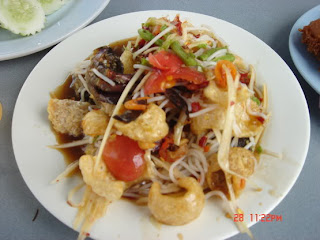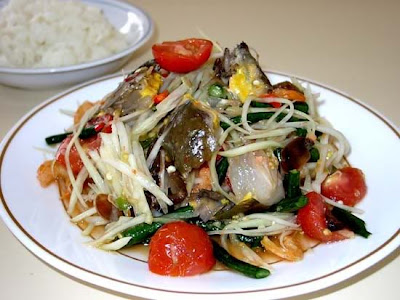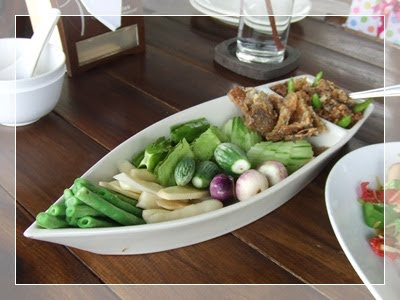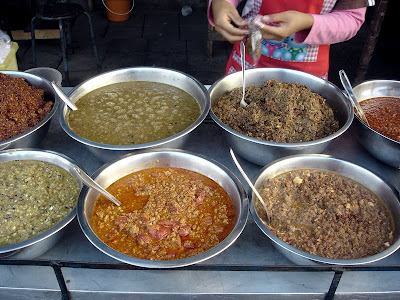Pic Left; Som Tam Thai
Som Tam (papaya salad), is a dish that has come to be known and loved by people all over the world. Although most Westerners who didn't get further than their local Thai restaurant in their countries, or the Bungalow/resort restaurant where they stayed whilst in Thailand will perhaps not have seen any of the myriad variations of Som Tam that are to be found in existence. Most tourism orientated establishments only serve Som Tam Thai, which is a sweet tasting concoction using green papaya, carrot, chili, tomato and peanuts with some cane syrup, dried shrimps, fish sauce, msg, lime juice, green beans and schallots. This is the easiest and most universal type of som tam available, as well as the most palatable to general tatses. But for the more adventurous, and most definitely Thai people, there are many other versions which are mostly preferred by the locals in Thailand. The number one preference must be i thing Som Tam Phu Kem Pla Ra (either both Phu Kem and Pla Ra, or sometimes just Phu Kem for those who cannot manage the pungent taste of Pla Ra). Phu kem means salted preserved freshwater crab, and Pla Ra is a kind of salted fermented raw fish, which is placed in salt water in a pot called a "Hai" for a period of up to 2 years to ferment.
Pic left; Pla Ra fermented fish in the Hai
The Pla Ra is then bashed into the Som Tam using the pestle and mortar. Isan people(Northeast Thailand) tend to love Pla Ra the most whereas central Thais cannot stomach it. I myself can't live without it and ask for a few pieces to be put into the som tam so i can chew on the salty raw fish (mmm its sooo good). Many people just ask for the juice from the Hai pot where the fish are preserved in as this in itself has a very pungent and spicy/salty taste. In isan country many people (if in familiar company) will not call it Pla ra, rather "Pla daek", but you shouldn't use this term unless you are with your closest family or intimate friends who can take the coarse speech. Daek means fooder, which is the verb for feeding used solely for animals and not for humans, but although central Thais will scold you for using this term, it is still actually used in general in intimate company or when joking by many Thai people. Not practising what is preached is anyway the norm in the land of smiles (??), so take your scoldings with a pinch of salt.
Picture left; Som Tam Phu Ma
One of my other favourites is Som Tam Phu Ma (Papaya salad with raw blue crab). Phu means crab and Ma means horse.. so; som tam with horse crabs it is. The meat of the horse crab is so fresh and the use of sweet sugar cane paste in the som tam serves to increase the juicy texture of the crab meat. the variations you will find with every single som tam recipe is perhaps as many as the amount of stalls in Thailand, due to the fact that every "Mae Krua" (cook) makes it a ddifferent way according to personal taste. In any case, in Thailand the person ordering always has the right to define exactly which "Soot" they want (soot means "formula"). So you can ask to drop a certain ingredient or exchange it for another. There are therefore almost limitless variations on the way you can have your som tam (sweet, sour, spicy, salty..) as well as the different ingredients which can be added.

I believe 'Tam Sua" (som tam with "Khanom Jeen" ) to be the favourite with the ladies, and you don't see men eat it so often. Khanom jeen is the fresh white string noodles which can be seen eaten early mornings with thin curry sauce and fresh vegetables. The papaya, tomato, green beans, pla ra chilis, nam tan beeb (cane sugar) etc are loosely mixed together with the fresh noodles and served with a slice of lime. This is really a staple snack for Thai ladies of the Northeastern provinces, and perhaps the staple diet of Thailand's "ladies of the Night".
Personally i am unable to eat anything without rice or sticky rice, although central Thais eat som tam just on it's own, the real eater of Isan food should not go without sticky rice. I can put about 3 5 baht bags of it away to one plate of som tam, which i usually order with "laap" or "Hmoo nam tok" as an added dish ( i shall be presenting those dishes in a separate post).
Tam Pha is a real rustical style using natural ingredients (aharn Pha in Thai means rustical or plucked from the wild - wild game is also Aharn Pha; such as cooked hare, wild bird or wild chicken, squirrel, wild boar meat etc) The one above has "Hnor Mai bai ya nang" in it (bamboo marinated in Bai Ya Nang leaf juice). This is a pretty earthy, gamy tasting kind of som tam and for hardcore style only. Not for the delicate palate. I love bai ya nang anyway with hnor mai, which can be eaten as a soup and with sticky rice





























